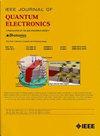Shaping Current Accurately to Suppress the Transient Chirp for Multi-Level PAM Signals of Directly Modulated DFB Lasers
IF 2.1
3区 工程技术
Q3 ENGINEERING, ELECTRICAL & ELECTRONIC
引用次数: 0
Abstract
Low-cost direct modulation direct detection (DM-DD) systems in optical communications are severely limited by transient chirps when adopting higher-order modulation formats to meet the high-capacity transmission. To break through this constraint, a shaping current waveform technique combined with multi-level pulse amplitude modulation (PAM) is proposed to suppress the transient chirp of directly modulated distributed feedback (DFB) lasers. This pre-compensation technique only requires simply changing the injected current waveform, which in combination with phase space trajectories visualizes the effect of the technique in obtaining the optimum output from the laser. Experiments show that the pre-compensation technique can minimize the transient chirp of higher-order modulated signals and reduce the overshoot of the eye diagram. Furthermore, to further validate the effectiveness of the pre-compensation technique, the eye diagrams are compared and analyzed at the receiver side. The simulation results show that the current shaping technique achieves the desired laser output, which could improve the higher-order modulation performance of the DM-DD system.精确整形电流抑制直接调制DFB激光器多级PAM信号的瞬态啁啾
低成本直接调制直接检测(DM-DD)系统在采用高阶调制格式以满足大容量传输时,会受到瞬态啁啾的严重限制。为了突破这一限制,提出了一种结合多级脉冲调幅(PAM)的整形电流波形技术来抑制直调分布反馈(DFB)激光器的瞬态啁啾。这种预补偿技术只需要简单地改变注入电流波形,它与相空间轨迹相结合,可以直观地看到该技术在获得最佳激光输出方面的效果。实验表明,预补偿技术能有效地减小高阶调制信号的瞬态啁啾,降低眼图的超调。此外,为了进一步验证预补偿技术的有效性,在接收端对眼图进行了比较和分析。仿真结果表明,采用电流整形技术可以获得理想的激光输出,提高了DM-DD系统的高阶调制性能。
本文章由计算机程序翻译,如有差异,请以英文原文为准。
求助全文
约1分钟内获得全文
求助全文
来源期刊

IEEE Journal of Quantum Electronics
工程技术-工程:电子与电气
CiteScore
4.70
自引率
4.00%
发文量
99
审稿时长
3.0 months
期刊介绍:
The IEEE Journal of Quantum Electronics is dedicated to the publication of manuscripts reporting novel experimental or theoretical results in the broad field of the science and technology of quantum electronics. The Journal comprises original contributions, both regular papers and letters, describing significant advances in the understanding of quantum electronics phenomena or the demonstration of new devices, systems, or applications. Manuscripts reporting new developments in systems and applications must emphasize quantum electronics principles or devices. The scope of JQE encompasses the generation, propagation, detection, and application of coherent electromagnetic radiation having wavelengths below one millimeter (i.e., in the submillimeter, infrared, visible, ultraviolet, etc., regions). Whether the focus of a manuscript is a quantum-electronic device or phenomenon, the critical factor in the editorial review of a manuscript is the potential impact of the results presented on continuing research in the field or on advancing the technological base of quantum electronics.
 求助内容:
求助内容: 应助结果提醒方式:
应助结果提醒方式:


